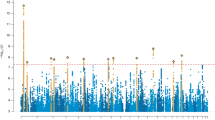Abstract
Although the etiology of attention-deficit/hyperactivity disorder (ADHD) is likely multifactorial, family,1 adoption,2 and twin studies3 suggest that genetic factors contribute significantly. Polymorphisms of the dopamine 4 receptor (DRD4) affect receptor binding,4 and one allele with seven tandem repeats in exon 3 (DRD4*7R) has been associated with ADHD.5,6 We examined this putative association in 41 children with severe ADHD and 56 healthy controls who were group matched for ethnicity and sex. The frequency of the DRD4*7R allele did not vary by diagnosis (0.220 vs 0.205 in patients and controls, respectively). Behavioral and brain anatomic MRI measures, previously found to discriminate patients from controls,7 did not differ significantly between subjects having and those lacking a DRD4*7R allele. These data do not support the reported association between DRD4*7R and the behavioral or brain morphometric phenotype associated with ADHD.
Similar content being viewed by others
Author information
Authors and Affiliations
Corresponding author
Rights and permissions
About this article
Cite this article
Castellanos, F., Lau, E., Tayebi, N. et al. Lack of an association between a dopamine-4 receptor polymorphism and attention-deficit/hyperactivity disorder: genetic and brain morphometric analyses. Mol Psychiatry 3, 431–434 (1998). https://doi.org/10.1038/sj.mp.4000430
Received:
Revised:
Accepted:
Published:
Issue Date:
DOI: https://doi.org/10.1038/sj.mp.4000430
- Springer Nature Limited
Keywords
This article is cited by
-
Genetic variations influence brain changes in patients with attention-deficit hyperactivity disorder
Translational Psychiatry (2021)
-
DRD4 48 bp multiallelic variants as age-population-specific biomarkers in attention-deficit/hyperactivity disorder
Translational Psychiatry (2020)
-
The dopamine D4 receptor: biochemical and signalling properties
Cellular and Molecular Life Sciences (2010)
-
Association of 4-Repeat Allele of the Dopamine D4 Receptor Gene Exon III Polymorphism and Response to Methylphenidate Treatment in Korean ADHD Children
Neuropsychopharmacology (2007)
-
Differential effects of DRD4 and DAT1 genotype on fronto-striatal gray matter volumes in a sample of subjects with attention deficit hyperactivity disorder, their unaffected siblings, and controls
Molecular Psychiatry (2005)




